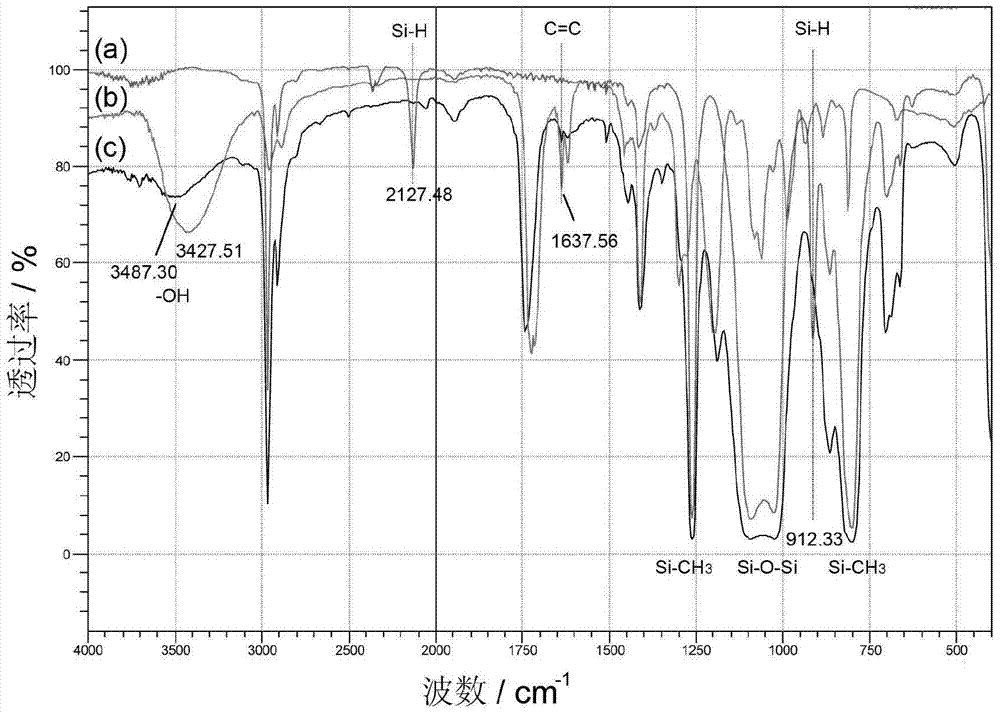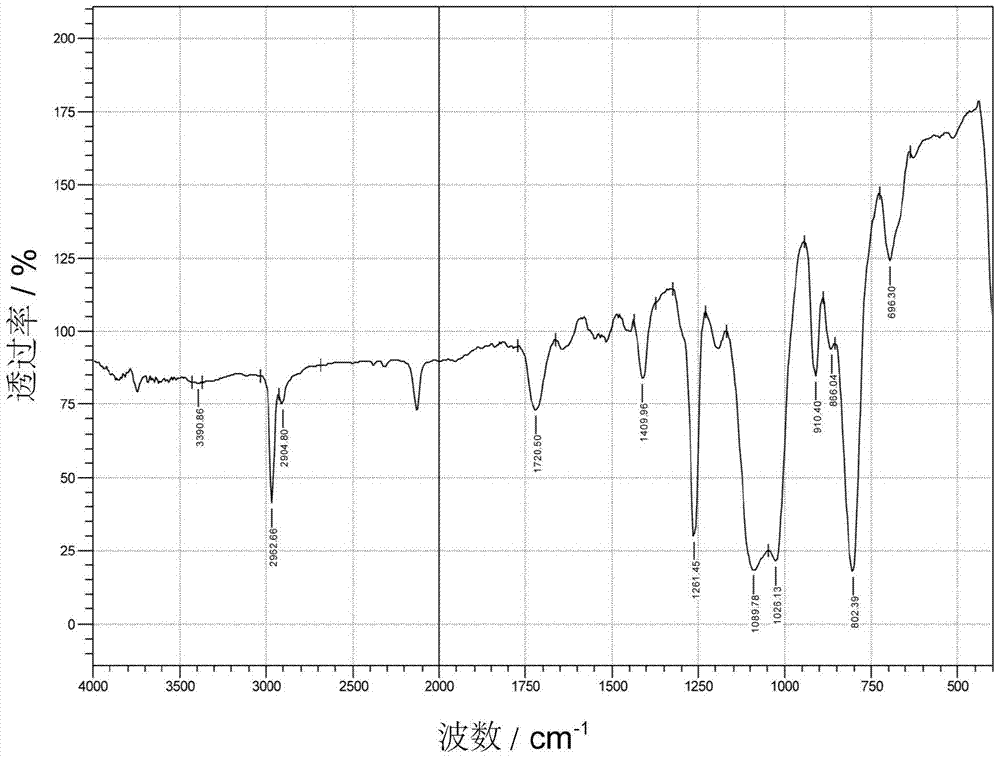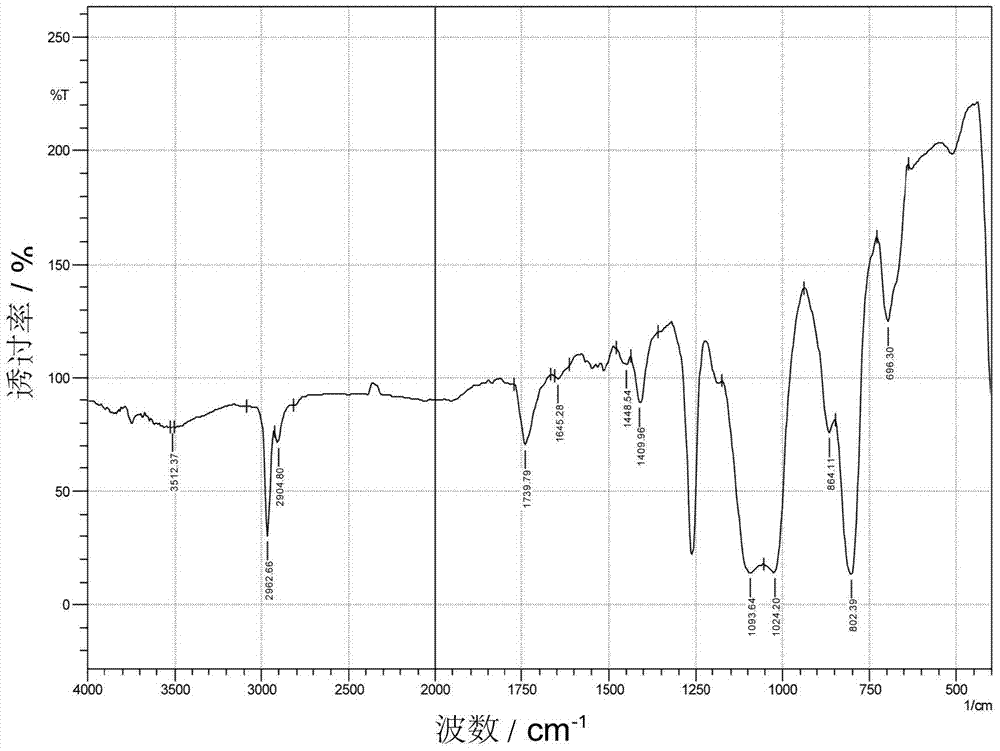Extra-flexible imitation active pigment printing formaldehyde-free adhesive and its preparation method and application
A paint printing, imitation reactive technology, applied in dyeing, textile and papermaking, etc., can solve the problems of stiff hand feeling, easy sticking to rollers, poor color fastness, etc. of printed fabrics, and achieve soft hand feeling, good adhesion and fastness. Good results
- Summary
- Abstract
- Description
- Claims
- Application Information
AI Technical Summary
Problems solved by technology
Method used
Image
Examples
Embodiment 1
[0075] Add 100g terminal hydrogen-containing polysiloxane, 11.6g hydroxyethyl acrylate (C=C:Si—H molar ratio 1.0:1.0), 111.6g toluene ( 100% of the total weight of the reaction raw materials), 0.58g hydroquinone (0.05% of hydroxyethyl acrylate), through N 2 After three replacements, the temperature was gradually raised to 90° C., and 11.2 g of 1 wt % chloroplatinic acid-ethanol solution (378 ppm) was added as a catalyst. The system heats up rapidly. After the system temperature is stable, gradually raise the temperature to 95°C for 3 hours. After the reaction, cool down to room temperature. Wash with water three times to remove unreacted hydroxyethyl acrylate. , Toluene was removed under reduced pressure at -0.090MPa vacuum. Cool down to room temperature and filter to obtain acyloxy-terminated hydroxyethyl polysiloxane. The infrared spectra of hydrogen-terminated polysiloxane, hydroxyethyl acrylate and acyloxy-terminated hydroxyethyl polysiloxane are as follows: figure 1 sh...
Embodiment 2
[0077] In a 250mL three-necked flask equipped with a thermometer, a stirrer and a condenser tube, add 100g of terminal hydrogen-containing polysiloxane, 26.0g of hydroxypropyl acrylate (C=C:Si—H molar ratio 2.0:1.0), 0.26g of p-phenylene Diphenol (1% of hydroxypropyl acrylate), thru N 2 Replaced three times, gradually raised the temperature to 90° C., and added 33.46 g of 1 wt % chloroplatinic acid-isopropanol solution (1000 ppm). The temperature of the system was raised rapidly, and after the temperature of the system was stabilized, the temperature was gradually raised to 100° C. for 3 hours. Cool down to room temperature after the reaction, wash with water three times to remove excess hydroxypropyl acrylate, add an appropriate amount of toluene to raise the temperature to remove water after water separation. Then the temperature was raised to 100°C, and the toluene was removed under reduced pressure at -0.090MPa vacuum. Cool down to room temperature and filter to obtain a...
Embodiment 3
[0079] In a 250mL three-necked flask with a thermometer, a stirrer and a condenser tube, add 50g of hydrogen-containing polysiloxane, 12.8g of hydroxyethyl acrylate (C=C:Si—H molar ratio 1.1:1.0), 50g of toluene (reaction 79.6% of the total weight of the raw material), 0.2g 2-tert-butyl hydroquinone (1.56% of hydroxyethyl acrylate), through N 2 Replace three times, gradually raise the temperature to 90° C., and add 0.01 g of platinum dioxide (137 ppm) as a catalyst. The temperature of the system was raised rapidly, and after the temperature of the system was stabilized, the temperature was gradually raised to 95° C. for 5 hours. After the reaction was completed, it was lowered to room temperature, washed with water three times to remove excess hydroxyethyl acrylate, and after water separation, the temperature was raised and the toluene was refluxed with water. Then the temperature was raised to 100°C, and the toluene was removed under reduced pressure at -0.090MPa vacuum. Co...
PUM
 Login to View More
Login to View More Abstract
Description
Claims
Application Information
 Login to View More
Login to View More - R&D
- Intellectual Property
- Life Sciences
- Materials
- Tech Scout
- Unparalleled Data Quality
- Higher Quality Content
- 60% Fewer Hallucinations
Browse by: Latest US Patents, China's latest patents, Technical Efficacy Thesaurus, Application Domain, Technology Topic, Popular Technical Reports.
© 2025 PatSnap. All rights reserved.Legal|Privacy policy|Modern Slavery Act Transparency Statement|Sitemap|About US| Contact US: help@patsnap.com



